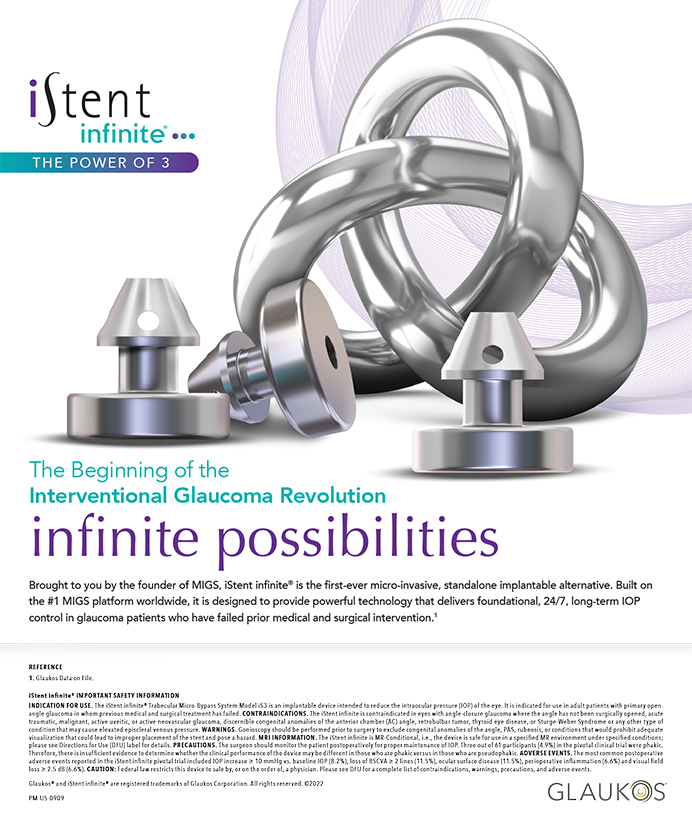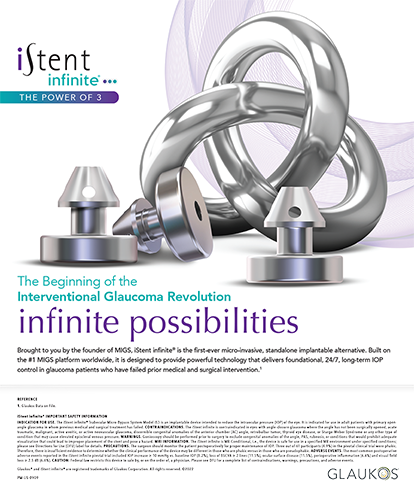CASE PRESENTATION
A 50-year-old man with a history of RK 10 years ago presents about 6 months after suffering blunt trauma to the eye. Iris tissue was lost through an open RK incision at 9 o'clock. The surgeon repaired the open globe with a 10–0 nylon suture, which has been removed. During the subsequent 6 months, the patient has noticed a decrease in vision, with disabling glare from the loss of iris and cataract progression (Figure 1). The patient would like to undergo surgery for the cataract and, if possible, the iris defect. How would you proceed?
KEVIN M. MILLER, MD
There are multiple ways to address this patient's cataract and partial aniridia using devices from Morcher GmbH, Ophtec BV, or HumanOptics AG. Not a single “pseudiridia” implant has been approved by the FDA. Ophthalmologists in the United States who wish to implant aniridia devices must obtain a compassionate use exemption from the FDA and the approval of a local institutional review board.
The surgeon could implant two Morcher 50F modified capsular tension rings (CTRs) in the capsular bag in front of a standard IOL. He or she would align the occluder paddles on one ring with the slits on the other to construct an artificial iris with a 4-mm pupil. One drawback to this approach is that it does not prevent light from entering peripheral to the capsular equator. Another problem is that the aniridic portion of the eye remains black (Figure 2).
Another solution is a Morcher iris reconstruction lens. My preferred Morcher device is the model 67B because of its 3-mm pupil. The device can be implanted in the capsular bag with difficulty or in the ciliary sulcus with ease. The 67B has three drawbacks: (1) it requires an 11-mm incision for implantation, (2) its 10-mm diameter is insufficient to completely block light from entering the eye peripheral to the artificial iris, and (3) the aniridic portion of the eye remains black (Figure 3).
A cosmetic alternative to this Morcher implant is the Ophtec 311 iris reconstruction lens, which is available in blue, green, and brown. This patient would be a good candidate for the brown model. Like the Morcher iris reconstruction lens, the Ophtec device can be implanted in the capsular bag with difficulty or in the ciliary sulcus with ease. Problems with this implant include its 4-mm pupillary size, the 9-mm diameter of the artificial iris, the lack of matching color and texture, and the size of incision required for the device's implantation (Figure 4).
The CustomFlex artificial iris manufactured by HumanOptics currently represents the best approach for eyes with cataract, intact zonules, and partial or complete aniridia. The device can be color matched to the patient's fellow eye and implanted through a 4-mm or smaller incision. This prosthesis can be placed inside the capsular bag in front of an IOL or in the ciliary sulcus. When implanted in the sulcus, the device does an excellent job of blocking out all light peripheral to the iris (Figure 5).
KENNETH J. ROSENTHAL, MD
This patient presents with a large iris defect and a cataract. Although the iris defect was caused by the iris' prolapse through one of the RK incisions, the “trampolining” of the lens might have caused an underlying zonular defect, which may need to be addressed by the insertion of a CTR. Because the iris defect is too large to permit a satisfactory primary closure, an iris prosthesis can be implanted. The Ophtec iris prosthetic implant is available as either a single-piece device that includes the IOL (model 311) or as a modular iris implant (Iris Prosthetic System) intended for placement in the capsular bag. The model 311 requires an incision of approximately 9 mm. The advantage of the Iris Prosthetic System is that it can be inserted through a 4-mm incision.
A more aesthetically pleasing and minimally invasive approach would be to implant the CustomFlex. Made of a silicone elastomer, the device is hand colored based on a photograph of either the injured iris or the fellow eye's iris and closely matched to the existing iris. Once implanted, the prosthesis is virtually undetectable. An additional advantage of this device is that it can be delivered through a 2.7-mm incision via a Silver unfolder (Abbott Medical Optics Inc.). The prosthesis can be cut to size, implanted whole, and either placed in the sulcus or sutured to the existing iris.
In this case, I would most likely cut a CustomFlex implant to size, replace the missing section of iris, and leave the intact portion of the tissue without an iris prosthesis. I would suture the device to the edges of the iris defect with mattress-placed, double-armed 10–0 polypropylene sutures. This approach would allow the residual, functioning pupil to dilate and constrict.
The residual iris can be dilated, creating access to the posterior chamber. The patient's residual refractive error—frequently present in post-RK eyes undergoing cataract surgery—could therefore be treated by a sulcusfixated IOL of a material dissimilar to the primary IOL in the bag. Alternatively, I have developed a technique in which a piggyback (or primary) IOL can be placed in the anterior chamber and the haptics sutured to the anterior surface of the iris.1
MICHAEL E. SNYDER, MD
Cataract surgery alone is unlikely to resolve all of this patient's complaints. The missing iris tissue would permit light to strike the edge of the implant's lens optic, and light would pass through the temporal aphakic space. This could result in a monocular, shadowed second image, a reduction in the contrast of the primary focused image, or both. Optical phenomena are particularly common in post-RK multifocal corneas. Although an iris repair might be attempted, closing a defect of nearly 4 clock hours with sutures alone is not likely to be fully successful. Moreover, the temporal location maximizes the likelihood of unpleasant optical symptoms in the event that the suturing technique fails.
Placing an iris prosthesis in such cases is likely to mitigate or alleviate photic symptoms. I prefer to use small-incision devices placed completely within the capsular bag when possible as opposed to devices with a large diaphragm, which call for incisions of between 9 and 10 mm. The Morcher 50 and 96 series of black PMMA devices can be placed through nearly phaco-sized incisions and can be very helpful in limiting light's access to the posterior segment. Cosmesis with these devices is unchanged.
In this case, I would prefer a CustomFlex device. The device is placed in front of the PCIOL within the bag. It would be necessary to adjust the IOL power by estimating a slight decrease in IOL effectiveness, because the optic will rest slightly more posteriorly within the capsular bag relative to the zonular plane. Capsular staining is crucial for the placement of any iris prosthesis within the capsular bag (Figure 6).
DIAMOND Y. TAM, MD
The surgeon must remove the cataract, implant an IOL, and address the missing iris tissue. A careful preoperative evaluation of zonular integrity and the corneal endothelium would be required. Intraoperatively, the surgeon would have to be prepared to use a device to support the zonules such as a CTR or a scleral-fixated Ahmed Capsular Tension Segment (Morcher GmbH; distributed in the United States by FCI Ophthalmics, Inc.) with the assistance of iris or capsular retractors. Once the cataract had been removed and an IOL securely placed, the surgeon could turn his or her attention to addressing the iris.
When repairing iris defects, I prefer to use as much of the native tissue as possible. I find that this approach typically provides the patient with the most cosmetically satisfying outcome, and it may allow me to avoid challenges such as color matching to the other eye with iris prosthetic devices. In this case, it might be possible to combine suture-mediated reapposition of the iris' edges with multiple iridodialysis mattress sutures to close the relatively large defect. That determination, however, usually cannot be made until the time of surgery with borderline large iris defects. In the event that adequate repair were impossible using the patient's own iris, an iris prosthetic device would be indicated. Of the current options, I prefer the CustomFlex, which can be injected through a cataract surgery incision, implanted in the capsular bag or unfolded in the sulcus and fixated to the sclera with Prolene sutures (Ethicon, Inc.) (Figure 7).
THOMAS OETTING, MS, MD: HOW THE CASE WAS MANAGED
The patient was admitted into a phase 3 study for the Ophtec 311 iris reconstruction IOL. I created a peritomy from about the 7- to the 11-o'clock position. Then, I made a 9-mm groove in the sclera but made sure that a thin strip of scleral tissue was present between the groove and the cornea to protect the RK incisions from separation. In the center of the groove, I used a keratome to make an initial incision of 3 mm into the anterior chamber. Next, I instilled a viscous dispersive ophthalmic viscosurgical device (OVD) into the area of missing iris tissue. The subsequent placement of a cohesive OVD over the lens pushed the dispersive OVD into the area of missing iris (sideways Arshinoff shell).
The capsulorhexis was uneventful. I removed the lens with a chopping technique and observed mild generalized weakness of the zonules. After placing a 13-mm CTR, I extended the wound to the right and left with corneoscleral scissors to about 9 mm. I then implanted a brown Ophthec model 311 prosthesis in the ciliary sulcus. I closed the wound with a 10–0 nylon suture. Fortunately, the RK incisions remained intact throughout the case (Figure 8).
Editor's note: both Dr. Miller and Dr. Rosenthal helped to develop the Morcher 50F CTR. Visit www.morcher.com for details.
Section Editor Bonnie A. Henderson, MD, is a partner in Ophthalmic Consultants of Boston and an assistant clinical professor at Harvard Medical School. Tal Raviv, MD, is an attending cornea and refractive surgeon at the New York Eye and Ear Infirmary and an assistant professor of ophthalmology at New York Medical College in Valhalla.
Section Editor Thomas A. Oetting, MS, MD, is a clinical professor at the University of Iowa in Iowa City. He acknowledged no financial interest in the product or company he mentioned. Dr. Oetting may be reached at (319) 384-9958; thomas-oetting@uiowa.edu.
Kevin M. Miller, MD, is the Kolokotrones professor of clinical ophthalmology at the David Geffen School of Medicine at UCLA and Jules Stein Eye Institute in Los Angeles. He is an investigator in the clinical trials of the Ophtec 311 iris reconstruction lens and the HumanOptics Artificial Iris. He holds his own investigational device exemption from the FDA to implant Morcher artificial iris devices. He stated that he receives no financial compensation from any of the companies he mentioned. Dr. Miller may be reached at (310) 206- 9951; kmiller@ucla.edu.
Kenneth J. Rosenthal, MD, is the surgeon director at Rosenthal Eye Surgery. Dr. Rosenthal is also an attending cataract and refractive surgeon at the New York Eye and Ear Infirmary and an associate professor of ophthalmology at the John A. Moran Eye Center, University of Utah School of Medicine, Salt Lake City. Dr. Rosenthal is a consultant to, receives honororia from, and is reimbursed for travel expenses by Alcon Laboratories, Inc., and Bausch + Lomb. He is reimbursed for travel expenses by and receives other perquisites from Ophtec BV. Dr. Rosenthal may be reached at (516) 466-8989; kenrosenthal@eyesurgery.org.
Michael E. Snyder, MD, is in private practice at the Cincinnati Eye Institute and is a voluntary assistant professor of ophthalmology at the University of Cincinnati. He is a consultant to HumanOptics AG. Dr. Snyder may be reached at (513) 984-5133; msnyder@cincinnatieye.com.
Diamond Y. Tam, MD is in private practice at Credit Valley Eye Care in Mississauga, Ontario, Canada. He acknowledged no financial interest in the products or companies he mentioned. Dr. Tam may be reached at diamondtam@gmail.com.


